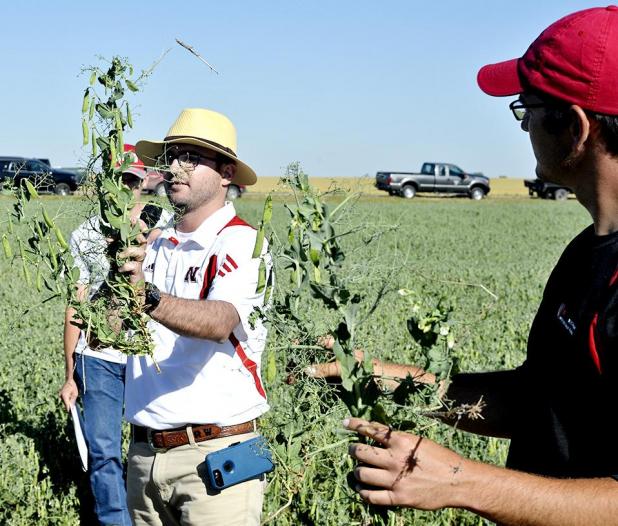
www.johnsonpublications.com/zenfolio Russ Pankonin | Johnson Publications
UNL Cropping Specialist Rodrigo Werle of North Platte (left) and Cropping Specialist Strahinja Stepanovic of Grant (right) display some pea plants during a field tour June 20 heldby the Henry J. Stumpf International Wheat Center in Grant.
Field pea research continues to evolve
This is the second of two stories looking at the research work on wheat and field peas at the Henry J. Stumpf International Wheat Center in Grant.
By Russ Pankonin
Grant Tribune-Sentinel
Research on field peas as an additional dryland rotational crop continues to evolve.
Crop researchers with the University of Nebraska and Kansas State University shared their ongoing work during a field day June 20.
More dryland farmers are considering field peas as a rotational crop.
Researchers have proven that farmers can implement a wheat-corn-field pea rotation. Without peas in the rotation, ground sits idle one year out of three.
During the field day, tour participants visited a university plot site northwest of Brandon on land owned by Steve Tucker of Venango.
Tucker has been an early adopter of growing field peas and also grows certified field pea seed with Jeff Olsen of Imperial.
He has also worked closely with the university on their research.
The field pea plot tour was followed by a wheat plot tour at the Henry J. Stumpf International Wheat Center just outside of Grant.
The afternoon session at the center was highlighted by roundtable discussions on peas and wheat.
Plant early to beat the heat
Cropping Specialist Rodrigo Werle said planting early represents one of the key factors in field peas.
By early, he means late March or early April. The earlier, the better, he said.
The field pea plant will put on flowers anywhere from 55-64 days after planting. Plant too late and those flowers can get hammered by high temperatures.
Werle said temperatures above 85°F will hurt the flowering process and reduce yield.
On their plot near Brandon, Werle said peas planted on March 17 were done flowering before hot temperatures hit. As a result, the plants are in good condition.
Peas planted in early April fared well but those planted in late April got hit with heat right as they began flowering.
Seed handling, population
Strahinja Stepanovic, UNL cropping specialist at the Stumpf Center, has been actively involved in the pea research as well.
He impressed on farmers that pea seed is especially sensitive. Each time the seed gets handled, it loses some germination quality.
While it’s not a scientific finding, Stepanovic said Kansas pea farmers swear that each time the seed touches iron, its germination decreases by 5 percent.
Use of steel augers when handling pea seed is not recommended.
Lucas Haag, agronomist at Kansas State’s Extension Center in Colby, said the minimum seeding rate is 350,000 seeds per acre. In 2016, they tested rates as high as 500,000 seeds per acre.
They have seven years of yield data on field peas at their Colby site. Yields have ranged as high as 56 bushels in 2016 to a low of 8 bushels in 2012.
Over the seven-year period, the yield on field peas has averaged 24 bushels per acre. He said heat during flowering remains a key factor in final yields.
Since seed handling is key, Stepanovic said it doesn’t pay to push the capacity of a drill to far.
Some farmers do a double planting, planting half the population each time, he said.
They use a diamond planting formation at 5 mph planting seed.
Haag said slowing down the shaft in drills and slowing down planting helps minimize damage of the seed, such as splitting.
Researchers also discussed the importance of seed innoculation prior to planting.
Weed control in peas can be a challenge due to the limited number of pre- and post-emergence herbicides.
Getting a uniform stand helps with weed control and bringing the crop to maturity at the same time.
Stepanovic said field peas can drop two to three points of moisture during a hot day. The drier the pea, the more chance for splitting.
A thick, uniform stand helps the plants dry down at the same rate, Tucker noted.
Cost vs. benefit
Farmers need to weigh whether getting an additional crop off a field that would normally be idle is worth more than the possibility of reduced wheat yields the following year.
Haag said field peas will use 3.52 inches more of water than what would have been used in the summer fallow.
He said the moisture available at wheat planting is 2.55 inches less behind peas than a no-till fallow field.
As a result, he said wheat yields in Kansas have averaged about eight bushels less when following field peas versus summer fallow.
For each inch reduction in moisture available at wheat planting, wheat yields fall off 3.7 bushel, Haag said.
This marks the third year for production at the wheat center. Stepanovic said three-year averages are needed before being able to verify any patterns that are developing.
He said it looks like they may get some additional funding, enabling them down the road to make pea variety recommendations specifically for this region.
Crop outlook
It doesn’t appear this will be a break-out year for yields in Southwest Nebraska.
However, growing conditions in North Dakota, Montana and in to Canada, where a lot of peas are raised, have been dry and hot.
That raises the potential for higher prices later this fall.
One farmer noted this may be the year to put some peas in storage to see if higher prices emerge in the fall and early winter.
Currently, the cash price for field peas is in the $6.25-6.50 per bushel range.
